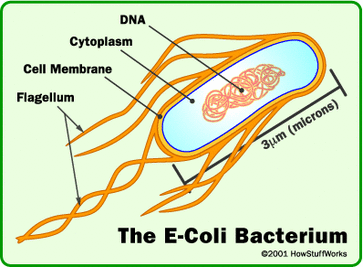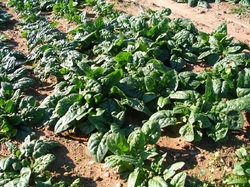About the Virus

E. Coli is one of the many species of bacteria that live in the lower intestines of mammals, including humans — one person excretes billions of them in a day. Most strands of E. Coli are beneficial to mammals, helping break down ruffage (plant matter) in the bowels. The dangers of certain strains of E. Coli are very serious, especially the most deadly strand, E. coli 0157:H7 . It is estimated that each year, over 2000 Americans are hospitalized and about 60 die as a direct result of E. Coli.

A person can obtain this pathogen from eating unwashed vegetables or fruit, raw fish or oysters, meat or eggs that have not been cooked properly, or untreated water. The deadly strain may appear in vegetables from the use of manuer in soil that may contain a deadly strain. The
The most deadly strain of E. coli (strain 0157:H7) produces Shiga toxin, also called Stx. This may cause serious problems in a person's digestive tract. The toxin itself is the most deadly component of this strain. It was transferred to the harmless E. coli bacteria by a bacteriophage (virus that infects bacteria) thus transferring genetic material needed to replicate the toxin. It is one of the most deadly toxins known to man because the bacteria that produce it can survive weeks on surfaces such as countertops and up to a year in materials such as compost. These organisms have a very low infectious dose meaning they can infect an organism in low numbers.
Signs and Symptoms
-Severe stomach cramps and tenderness
-Diarrhea, sometimes bloody
-Nausea and vomiting
-Loss of appetite
-Gas
-Fever
-Pale skin
These symptoms usually last a week, however in more serious cases, may last up to even 14 days. If left untreated, this may lead to severe blood and kidney issues. Some people carrying the pathogen may not notice any symptoms and could potentially pass it on to others.
The most deadly strain of E. coli (strain 0157:H7) produces Shiga toxin, also called Stx. This may cause serious problems in a person's digestive tract. The toxin itself is the most deadly component of this strain. It was transferred to the harmless E. coli bacteria by a bacteriophage (virus that infects bacteria) thus transferring genetic material needed to replicate the toxin. It is one of the most deadly toxins known to man because the bacteria that produce it can survive weeks on surfaces such as countertops and up to a year in materials such as compost. These organisms have a very low infectious dose meaning they can infect an organism in low numbers.
Signs and Symptoms
-Severe stomach cramps and tenderness
-Diarrhea, sometimes bloody
-Nausea and vomiting
-Loss of appetite
-Gas
-Fever
-Pale skin
These symptoms usually last a week, however in more serious cases, may last up to even 14 days. If left untreated, this may lead to severe blood and kidney issues. Some people carrying the pathogen may not notice any symptoms and could potentially pass it on to others.
